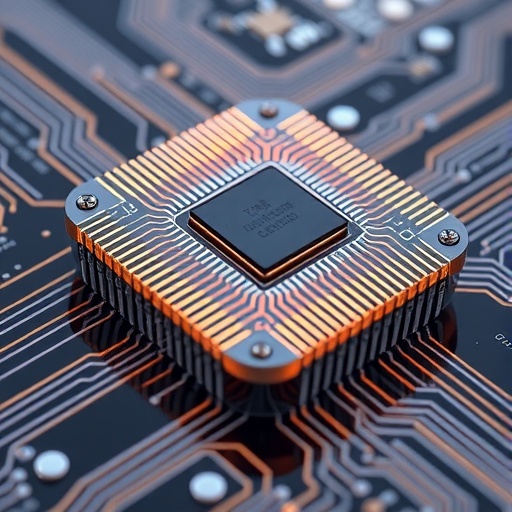In the ever-evolving landscape of biomedical technology, the advent of skin-like soft electronics marks a significant breakthrough in how we interface with biological tissues. These flexible electronic systems promise not just comfort and adaptability but also the potential for unprecedented monitoring capabilities crucial for health and therapeutics. Imagine a future where wearables seamlessly integrate with human physiology, providing real-time data that could revolutionize healthcare delivery and disease management.
To achieve this vision, high-performance intrinsically stretchable transistors are at the core of technological innovation. Unlike traditional rigid electronics, these advanced transistors can conform to the dynamic contours of the human body. This is particularly vital when considering tissues like skin, heart, or brain, which demonstrate significant flexibility and movement. The soft electronics designed with these transistors look to become the standard for applications such as continuous health monitoring, disease diagnostics, and even automated therapeutic interventions.
The operational principles behind intrinsically stretchable transistors are fascinating. They rely heavily on innovative materials that maintain conductivity and performance even under significant deformation. For instance, advanced polymers and organic semiconductors are being utilized to enhance field-effect mobility, a crucial parameter for boosting performance in short-channel devices. This innovation allows for faster operation speeds, which are essential for processing biological signals accurately and in real-time.
In tandem with material advancements, the design of these transistors is also evolving. Researchers are experimenting with novel device architectures that can better withstand mechanical stresses. Unlike conventional electronics that often fail under strain, the new designs incorporate features that enhance resilience and longevity. Concepts such as fractal and mesh-like layouts distribute mechanical stress more evenly, thereby ensuring operational stability even as the device flexes and stretches.
Low-voltage operation is another critical attribute of these stretchable transistors and related integrated circuits (ICs). With an increasing focus on patient safety and energy efficiency in biomedical applications, low-voltage designs will minimize risks while conserving power. This capability is particularly indispensable in wearable devices that require long-term monitoring without frequent recharging or invasive power sources.
As the complexity of integration increases, scalability becomes a major challenge in the production of these devices. To enable mass adoption, researchers are exploring various fabrication methods that ensure a high density of devices while maintaining reproducibility. Techniques like roll-to-roll processing and printed electronics are being scaled up to manufacture large arrays of transistors efficiently. This approach not only reduces costs but also accelerates the transition from laboratory settings to real-world applications.
Within the context of health applications, the potential for high-performance intrinsically stretchable transistors is vast. Imagine a wearable device that could monitor vital signs continuously and provide real-time feedback to users. This isn’t just a futuristic dream but a tangible goal that is getting closer due to ongoing research. Such devices could drastically alter the landscape of personal health monitoring, enabling proactive rather than reactive healthcare solutions.
Furthermore, the integration of these devices with existing therapeutic systems could lead to the development of closed-loop mechanisms in medicine, where treatment can be adjusted autonomously based on continuous readings. For instance, diabetic patients could benefit from insulin pumps equipped with sensors that monitor glucose levels in real-time, ensuring that insulin delivery is optimized without the need for constant manual intervention.
Soft robotics, too, stands to gain significantly from advancements in intrinsically stretchable electronics. Robots designed to mimic human motion or interact closely with human environments require soft, adaptive materials to function effectively. The ability of soft electronics to deform without losing functionality aligns perfectly with the demands of robotic systems designed for intricate tasks or physical interaction.
Moreover, the enhanced functionality provided by high-performance ICs will pave the way for new adaptive human-machine interfaces. Imagine controlling a computer or a smart home device through subtle gestures or physiological changes detected by wearable electronics. The integration depth promised by these technologies could redefine our relationship with machines, creating a more intuitive interface that feels natural and seamless.
The ongoing research in this domain is not merely academic; it holds the promise of changing lives. As these technologies mature, the implications extend to various fields including sports science, disaster response, and elderly care. The data collected through these systems can provide invaluable insights, enhancing not only individual health management but also public health interventions through aggregated data analytics.
In summary, the innovation journey toward high-performance intrinsically stretchable transistors heralds a transformative era in bioelectronics and health technology. With the confluence of advanced materials, smart device design, and manufacturing techniques, the potential applications are boundless. As researchers push the boundaries further, we stand on the brink of a future where electronics and biology merge more harmoniously than ever before.
The ambitious quest for high-performance intrinsically stretchable electronics is not without its challenges, but with every breakthrough, we are getting closer to unlocking a new paradigm of health monitoring and personalized care. The intersection of these fields may soon not only enhance our understanding of the human body but also shape the future of medical practices in ways we are just beginning to imagine.
The visions painted by these advancements may ultimately lead us toward a society where healthcare is more accessible, personalized, and efficient. Strengthening the interface between electronics and biology opens astonishing avenues for research and application, enabling innovations that have the capacity to profoundly impact our daily lives and health outcomes.
The future may very well belong to those who harness the capabilities of intrinsically stretchable electronics, providing the tools necessary for an unprecedented leap in health management. In a world where technology can address the intricacies of human biology, we could finally realize a healthier and more technologically integrated society.
Subject of Research: Development of high-performance intrinsically stretchable transistors and integrated circuits for healthcare applications.
Article Title: Intrinsically stretchable transistors and integrated circuits.
Article References:
Nishio, Y., Zhong, D., Kim, K.K. et al. Intrinsically stretchable transistors and integrated circuits.
Nat Rev Electr Eng 2, 715–735 (2025). https://doi.org/10.1038/s44287-025-00220-3
Image Credits: AI Generated
DOI: https://doi.org/10.1038/s44287-025-00220-3
Keywords: Intrinsically stretchable electronics, health monitoring, bioelectronics, integrated circuits, wearable technology, soft robotics, personalized healthcare.




